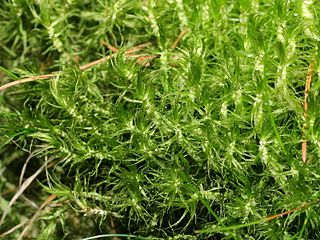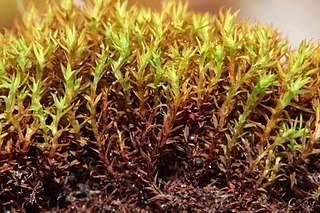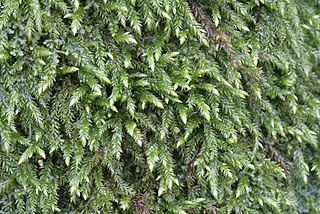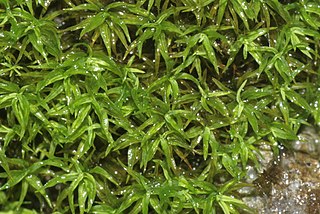
Funaria is a genus of approximately 210 species of moss. Funaria hygrometrica is the most common species. Funaria hygrometrica is called “cord moss” because of the twisted seta which is very hygroscopic and untwists when moist. The name is derived from the Latin word “funis”, meaning "a rope". In funaria root like structures called rhizoids are present.

Dicranum is a genus of mosses, also called wind-blown mosses or fork mosses. These mosses form in densely packed clumps. Stems may fork, but do not branch. In general, upright stems will be single but packed together. Dicranum is distributed globally. In North America these are commonly found in Jack pine or Red pine stands.

Gymnostomum is a genus of bryophyte in family Pottiaceae. It was first described by Christian Gottfried Daniel Nees von Esenbeck and Christian Friedrich Hornschuch
Molendoa is a genus of moss in family Pottiaceae.
Western Australia has relatively few species of moss; the most recent census found just 192 taxa. This represents just 10% of Australia's total moss flora, even though Western Australia accounts for about one third of the Australia by area. This relatively low diversity has been attributed to the lack of rainforest in the state.

Grimmia is a genus of mosses (Bryophyta), originally named by Jakob Friedrich Ehrhart in honour of Johann Friedrich Carl Grimm, a physician and botanist from Gotha, Germany.

The Pottiaceae are a family of mosses. They form the most numerous moss family known, containing nearly 1500 species or more than 10% of the 10,000 to 15,000 moss species known.

Tayloria is a genus of mosses in the family Splachnaceae. It comprises 45 species, divided among 6 subgenera:

Barbula is a genus of mosses in the family Pottiaceae.

Ditrichum is a genus of haplolepideous mosses (Dicranidae) in the family Ditrichaceae.

Leucobryum is a genus of haplolepideous mosses (Dicranidae) in the family Leucobryaceae. The name comes from the Greek leukos, meaning white, and bryon, meaning moss.

Tortula muralis, commonly known as wall- screw moss, is a species of moss in the family Pottiaceae. T. muralis is found throughout the world.

Syntrichia is a large, cosmopolitan genus of mosses in the family Pottiaceae. The genus name is of Greek origin for "plus" and "hair", referring to the "twisted peristome united by a basal membrane".

Didymodon is a genus of mosses belonging to the family Pottiaceae. The genus has a cosmopolitan distribution.

Bryoerythrophyllum is a genus of mosses belonging to the family Pottiaceae. It was first described by Pan Chieh Chen and has a cosmopolitan distribution.

Isothecium is a genus of mosses belonging to the family Lembophyllaceae. The genus has a cosmopolitan distribution.

Trichostomum is a genus of mosses belonging to the family Pottiaceae.
Pylaisia is a genus of mosses belonging to the family Pylaisiaceae.

Ptychostomum is a genus of mosses belonging to the family Bryaceae. It has an almost cosmopolitan distribution.
















